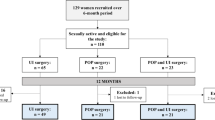Abstract
The objective of this study was to determine if vaginal stiffness index, an in vivo vaginal biomechanical property, is correlated with pelvic floor disorder symptom distress, impact on quality of life, or sexual function as measured by disease-specific quality-of-life scales. Forty-eight women completed validated quality-of-life scales (pelvic floor distress inventory-short form, pelvic floor impact questionnaire, and pelvic organ prolapse/urinary incontinence sexual questionnaire) and underwent in vivo vaginal biomechanical testing. After bivariate relationships between vaginal stiffness index and demographic, obstetric, and gynecologic variables were explored, multiple linear regression controlling for pelvic organ prolapse quantitative (POP-Q) stage of prolapse was performed. The vaginal stiffness index was inversely correlated with pelvic organ prolapse distress severity (POPDI-6) after controlling for POP-Q stage of prolapse (p = 0.011, r = 0.67, r 2 = 0.450, β = −2.3). These findings provide initial evidence for the construct validity of in vivo vaginal biomechanical testing for pelvic organ prolapse evaluation because an increasing vaginal stiffness index is correlated with decreasing symptomatic and anatomic severity of disease.

Similar content being viewed by others
References
Maolli PA, Shand SH, Zyczynski HM, Gordy SC, Meyn LA (2005) Remodeling of vaginal connective tissue in patients with prolapse. Obstet Gynecol 106:953–963
Gabriel B, Denschlag D, Göbel, H, Fittlow C, Werner M, Gitsch G, Watermann D (2005) Uterosacral ligament in postmenopausal women with or without pelvic organ prolapse. Int Urogynecol J 16:475–479
Rodrigues L, EEMCO Group (2001) EEMCO Guidance to the in vivo assessment of tensile functional properties of the skin: Part II Instrumentation and test modes. Skin Pharmacol Appl Skin Physiol 14:52–67
Pierard GE (1999) EEMCO guidance to the in vivo assessment of tensile functional properties of the skin. Part I. Relevance to the structures and aging of the skin and subcutaneous tissues. Skin Pharmacol Appl Skin Physiol 12:352–362
Epstein LB, Graham CA, Heit MH (2007) Systemic and vaginal biomechanical properties of women with normal vaginal support and pelvic organ prolapse. Am J Obstet Gynecol 197:165.e1–165.e6
Barber MD, Kuchibhatla MN, Pieper CF, Bump RC (2001) Psychometric evaluation of 2 comprehensive condition-specific quality of life instruments for women with pelvic floor disorders. Am J Obstet Gynecol 185:1388–1395
Barber MD, Walters MD, Bump RC (2005) Short forms of two condition specific quality-of-life questionnaires for women with pelvic floor disorders (PFDI-20 and PFIQ-7). Am J Obstet Gynecol 193:103–113
Rogers R, Kammerer-Doak D, Villarreal A, Coates K, Qualls C (2001) A new instrument to measure sexual function in women with urinary incontinence or pelvic organ prolapse. Am J Obstet Gynecol 184:552–558
Sandvik H, Seim A, Vanvik A, Hunskaar S (2000) A severity index for epidemiological surveys of female urinary incontinence: comparison with 48 hour pad weighing test. Neurourol Urodyn 19(2):137–145
Moalli PA, Talarico LC, Sung VW, Klingensmith WL, Shand SH, Meyn LA, Watkins SC (2004) Impact of menopause on collagen subtypes in the arcus tendineous fasciae pelvis. Am J Obstet Gynecol 190:620–627
Jackson S, James M, Abrams P (2002) The effect of oestradiol on vaginal collagen metabolism in postmenopausal women with genuine stress incontinence. BJOG 109:339–344
Vardy MD, Gardner TR, Cosman F, Scotti RJ, Mikhail MS, Preiss-Bloom AO, Williams JK, Cline MJ, Lindsay R (2005) The effects of hormone replacement on the biomechanical properties of the uterosacral and round ligaments in the monkey model. Am J Obstet Gynecol 192:1741–1751
Cox DA, Helvering LM (2006) Extracellular matrix integrity: a possible mechanism for differential clinical effects among selective estrogen receptor modulators and estrogens? Mol Cell Endocrinol 247:53–59
Barber MD, Walters MD, Cundiff GW, the PESSRI Trial Group (2006) Responsiveness of the Pelvic Floor Distress Inventory (PFDI) and Pelvic Floor Impact Questionnaire (PFIQ) in women undergoing vaginal surgery and pessary treatment for pelvic organ prolapse. Am J Obstet Gynecol 194:1492–1498
Dora CD, Dimarco DS, Zobitz ME, Elliott DS (2004) Time dependant variations in biomechanical properties of cadaveric fascia, porcine dermis, porcine small intestine submucosa, polypropylene mesh and autologous fascia in the rabbit model: implications for sling surgery. J Urol 171:1970–1973
Hilger WS, Walter A, Zobitz ME, Leslie KO, Magtibay P, Cornella J (2006) Histological and biomechanical evaluation of implanted graft materials in a rabbit vaginal and abdominal model. Am J Obstet Gynecol 195:1826–1831
Acknowledgments
Funding was provided by the June Allyson Foundation Research Fellowship Award. CyberDERM made a DermaLab machine with a 1.5-mm offset probe available at no charge.
Conflicts of interest
None.
Author information
Authors and Affiliations
Corresponding author
Rights and permissions
About this article
Cite this article
Epstein, L.B., Graham, C.A. & Heit, M.H. Correlation between vaginal stiffness index and pelvic floor disorder quality-of-life scales. Int Urogynecol J 19, 1013–1018 (2008). https://doi.org/10.1007/s00192-007-0551-1
Received:
Accepted:
Published:
Issue Date:
DOI: https://doi.org/10.1007/s00192-007-0551-1



